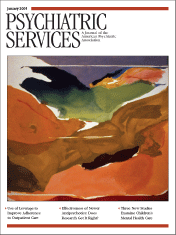Use of Long-Acting Risperidone
In Reply: We agree with all of the thoughtful, scientific points made by Drs. Pinninti and Mago until the sentence stating that 25 mg is higher than the dose of risperidone required for most patients with first-episode psychosis. Although no dose equivalency studies have been published that compare oral risperidone to long-acting injectable risperidone, the following information should be helpful. A dose of 25 mg given over 14 days is 1.8 mg a day. Peak plasma levels correlate with side effects, and peak levels for 25 mg of long-acting risperidone are approximately one-third less than with 2 mg of oral risperidone (1). Two recent posters presented data from evaluations of young patients with schizophrenia (a mean age of 23.2 years in one and 25 in the other) early in the course of their illness, which indicated that not only was long-acting risperidone effective (2) but extrapyramidal symptoms improved as well (3). My own personal observation is that patients who can tolerate 2 mg of risperidone orally can tolerate 25 mg of long-acting injectable risperidone. However, this does not obviate the point that a dose lower than 25 mg of long-acting risperidone may be helpful for some patients. As clinicians provide feedback on patients' needs, it is highly likely that the pharmaceutical industry will respond.
Dr. Parker's letter raises some critical issues about both the implications of sponsorship and the need to be all-inclusive about side effects. It was our impression that the disclosure we made in both our abstract and acknowledgment would permit readers to evaluate for themselves whether the sponsorship affected the content of the article. If Dr. Parker is correct that the readership of Psychiatric Services is not up to this task and that a delineation of the corporate structure of Johnson & Johnson would have made a difference, then we are grateful that he has clarified this for readers.
We support the full evaluation of diabetes risk and all other side effects. The purpose of the article was to take people beyond the package insert to the practical, clinical use of a new medication. If there are physicians using second-generation antipsychotics who have somehow missed the extensive literature on the risk of diabetes with use of these agents and the Food and Drug Administration's class-effect warning, then once again we are grateful to Dr. Parker for calling this to readers' attention.
As to Dr. Parker's assertions about the article by Dr. Citrome and his colleagues published in the same issue, his interpretation of the findings in regard to risperidone and diabetes appear to be somewhat negative. Of the four atypical antipsychotics evaluated, risperidone had the lowest odds ratio of risk elevation, which did not reach statistical significance. As Dr. Citrome and his colleagues are correct to point out, the study was naturalistic in design and therefore it is difficult to separate cause from effect. Perhaps risperidone was so frequently associated with multiple medication use because it has been perceived (as indeed was suggested in the Citrome article) to have a lower risk for diabetes than the other antipsychotics evaluated and was therefore potentially the safest choice for combination therapy. If a 21-day period of overlap during the discontinuation-initiation of second-generation antipsychotics constitutes polypharmacy, then I am guilty of polypharmacy. I would suspect that many opponents of polypharmacy (I am one) have used a double cross-over design for discontinuation-initiation of many medications (not, of course, MAOIs). If Dr. Parker has information about the inadvisability of this kind of discontinuation-initiation strategy, we hope he will share it with the field. Finally, none of these points should be interpreted as negating the FDA's warning on diabetes, which is a potentially quite severe consequence of the use of second-generation antipsychotic medications.
Our intention in writing our article was to bring the thoughts of people with extensive experience with a new medication to a journal widely read by other clinicians. We hope that we have succeeded, and we appreciate the interest, and even the criticism, of those who have read it. We would encourage the journal to continue to provide such clinical information to its readership.
1. Eerdekens M, Van Hove I, Remmerie B, et al: Pharmacokinetics and tolerability of long-acting risperidone in schizophrenia. Schizophrenia Research 70:91–100, 2004Crossref, Medline, Google Scholar
2. Saleem P, Firmino H, Parellada E, et al: Young patients (18 to 30 years old) with schizophrenia and schizoaffective disorder: results of direct switching to long-acting injectable risperidone. Presented at the Biennial Workshop on Schizophrenia, Davos, Switzerland, February 7–13, 2004Google Scholar
3. Lasser RA, Bossie C, Zhu Y, et al: Long-acting risperidone in young adults with schizophrenia or schizophrenia disorder. Presented at the annual meeting of the American Psychiatric Association, New York City, May 1–6, 2004Google Scholar



